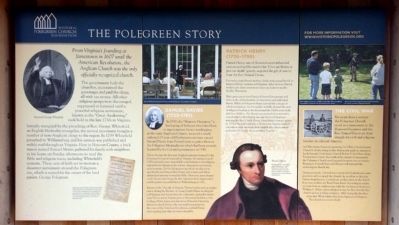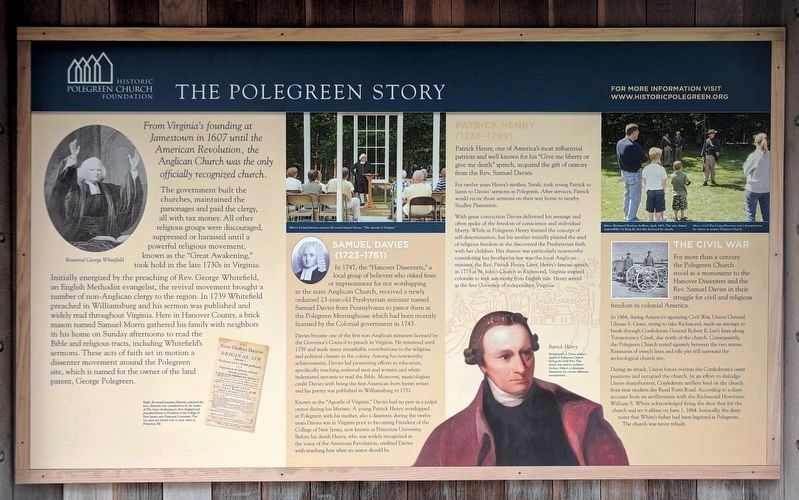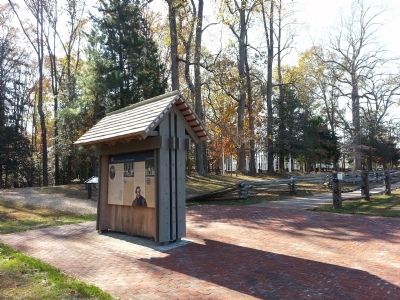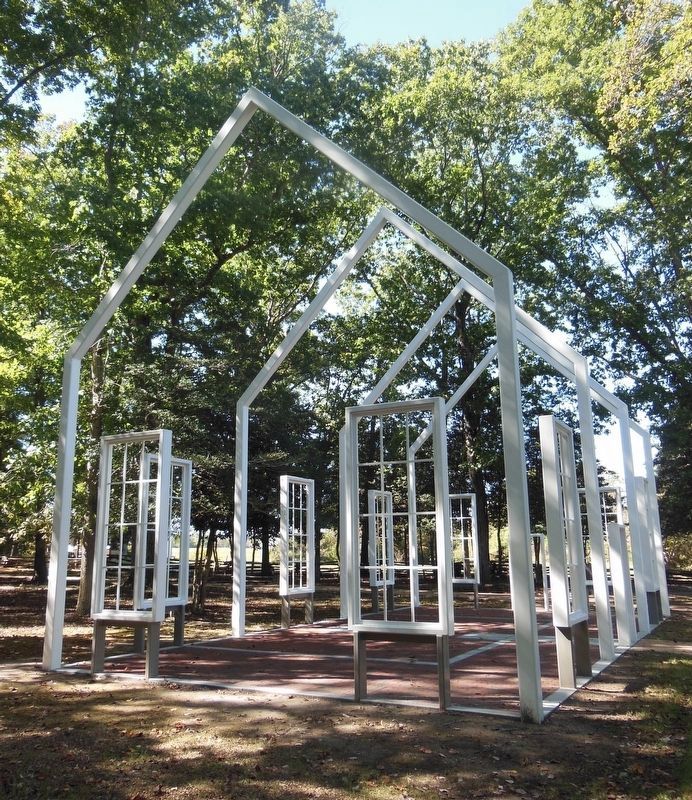Mechanicsville in Hanover County, Virginia — The American South (Mid-Atlantic)
The Polegreen Story
From Virginia’s founding at Jamestown in 1607 until the American Revolution, the Anglican Church was the only officially recognized church.
The government built the churches, maintained the parsonages and paid the clergy, all with tax money. All other religious groups were discouraged, suppressed or harassed until a powerful religious movement, kown as the “Great Awakening,” took hold in the late 1730s in Virginia.
Initially energized by the preaching of Rev. George Whitefield, an English Methodist evangelist, the revival movement brought a number of non-Anglican clergy to the region. In 1739 Whitefield preached in Williamsburg and his sermon was published and widely read throughout Virginia. Here in Hanover County, a brick mason named Samuel Morris gathered his family with neighbors in his home on Sunday afternoons to read the Bible and religious tracts, including Whitefield’s sermons. These acts of faith set in motion a dissenter movement around the Polegreen site, which is named for the owner of the land patent, George Polegreen.
Samuel Davies (1723-1761)
In 1747, the “Hanover Dissenters,” a local group of believers who risked fines or imprisonment for not worshipping at the state Anglican Church, received a newly ordained 23 year-old Presbyterian minister named Samuel Davies from Pennsylvania to pastor them at the Polegreen Meetinghouse which had been recently licensed by the Colonial government in 1743.
Davies became the first non-Anglican minister licensed by the Governor’s Council to preach in Virginia. He remained until 1759 and made many remarkable contributions to the religious and political climate in the colony. Among his noteworthy achievements, Davies led pioneering efforts in education, specifically teaching enslaved men and women and white indentured servants to read the Bible. Moreover, musicologists credit Davies with being the first American-born hymn writer and his poetry was published in Williamsburg in 1752.
Known as the “Apostle of Virginia,” Davies had no peer as a pulpit orator during his lifetime. A young Patrick Henry worshipped at Polegreen with his mother, also a dissenter, during the twelve years Davies was in Virginia prior to becoming President of the College of New Jersey, now known as Princeton University. Before his death Henry, who was widely recognized as the voice of the American Revolution, credited Davies with teaching him what an orator should be.
Patrick Henry (1736-1799)
Patrick Henry, one of America’s most influential patriots and well known for his “Give me liberty or give me death” speech, acquired the gift
of oratory from the Rev. Samuel Davies.
For twelve years Henry’s mother, Sarah, took young Patrick to listen to Davies’ sermons at Polegreen. After services, Patrick would recite those sermons on their way home to nearby Studley Plantation.
With great conviction Davies delivered his message and often spoke of the freedom of conscience and individual liberty. While at Polegreen Henry learned the concept of self-determination, but his mother initially planted the seed of religious freedom as she discovered the Presbyterian faith with her children. Her dissent was particularly noteworthy considering her brother-in-law was the local Anglican minister, the Rev. Patrick Henry. Later, Henry’s famous speech in 1775 at St. John’s Church in Richmond, Virginia inspired colonists to seek autonomy from English rule. Henry served as the first Governor of independent Virginia.
The Civil War
For more than a century the Polegreen Church stood as a monument to the Hanover Dissenters and the Rev. Samuel Davies in their struggle for civil and religious freedom in colonial America.
In 1864, during America’s agonizing Civil War, Union General Ulysses S. Grant, trying to take Richmond, made an attempt to break through Confederate General Robert E. Lee’s lines along Totopotomoy Creek, due north of the church. Consequently, the Polegreen Church rested squarely between the two armies. Remnants of trench lines and rifle pits still surround the archeological church site.
During an attack, Union forces overran the Confederate’s outer positions and occupied the church. In an effort to dislodge Union sharpshooters, Confederate artillery fired on the church from near modern day Rural Point Road. According to a diary account from an artilleryman with the Richmond Howitzers, William S. White acknowledged firing the shot that hit the church and set it ablaze on June 1, 1864. Ironically, the diary notes that White’s father had been baptized at Polegreen.
The church was never rebuilt.
For more information visit www.historicpolegreen.org
Erected 2012 by Historic Polegreen Church Foundation.
Topics. This historical marker is listed in these topic lists: Churches & Religion • Colonial Era • Patriots & Patriotism • War, US Civil. A significant historical month for this entry is June 1862.
Location. 37° 38.716′ N, 77° 19.795′ W. Marker is in Mechanicsville, Virginia, in Hanover County. Marker can be reached from the intersection of Heatherwood Drive (Virginia Route 1750) and Rural Point Road (Virginia Route 643). Touch for map. Marker is at or near this postal address: 6411 Heatherwood Drive, Mechanicsville VA 23116, United States of America. Touch for directions.
Other nearby markers. At least 8 other markers
are within walking distance of this marker. Welcome to Historic Polegreen Church (here, next to this marker); Polegreen Church (a few steps from this marker); Historic Polegreen Church (within shouting distance of this marker); a different marker also named Polegreen Church (within shouting distance of this marker); Site of Polegreen (within shouting distance of this marker); a different marker also named Polegreen Church (within shouting distance of this marker); The Reading Room (within shouting distance of this marker); Battle of Totopotomoy Creek (about 300 feet away, measured in a direct line). Touch for a list and map of all markers in Mechanicsville.
More about this marker. (captions)
Reverend George Whitefield
Right: Reverend Jonathan Edwards authored this tract. Edwards was considered to be the leader of The Great Awakening in New England and preceded Davies as President of the College of New Jersey, now Princeton University. The two men are buried next to each other in Princeton, NJ.
Above: Living historian portrays Reverend Samuel Davies, “The Apostle of Virginia.”
Patrick Henry
Background: A Union soldier’s sketch of Polegreen Church during the Civil War. This sketch was used by architect Carlton Abbott to determine dimensions for current silhouette interpretation.
Below: Richmond Howitzer Artillery, April, 1865. This unit claimed responsibility for firing the shot that destroyed the church.
Above: Civil War Living Historians lead demonstration for visitors at modern Polegreen Church.
Also see . . . Historic Polegreen Church Foundation. (Submitted on November 9, 2012, by Bernard Fisher of Richmond, Virginia.)
Credits. This page was last revised on June 21, 2021. It was originally submitted on November 9, 2012, by Bernard Fisher of Richmond, Virginia. This page has been viewed 775 times since then and 24 times this year. Photos: 1. submitted on November 9, 2012, by Bernard Fisher of Richmond, Virginia. 2. submitted on May 1, 2019, by Bernard Fisher of Richmond, Virginia. 3. submitted on November 9, 2012, by Bernard Fisher of Richmond, Virginia. 4. submitted on June 20, 2021, by Bradley Owen of Morgantown, West Virginia.



